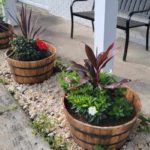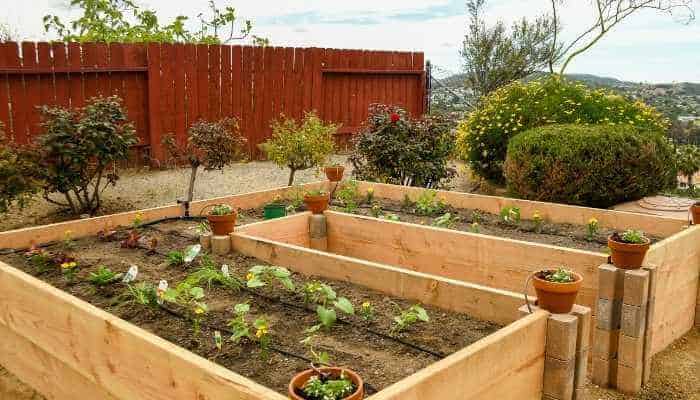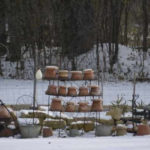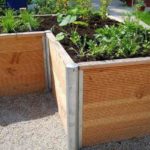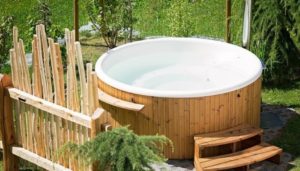I think it goes without saying that you need to keep your raised garden beds weeded. Part of what makes these beds so great is that there should be a lot less weeding than in a standard garden. And weeds will rob your plants of moisture, so that’s the simplest bit of advice I can give on this subject. However, there are more answers to this question…
If you want to keep your raised garden beds from drying out, amend the soil with organic material. Make sure it’s deep enough, cover it with a layer of compost or mulch, and plan to use a constant drip irrigation system or water the garden deeply and on schedule.
Someone has also said to build your garden in the shade, but that’s really not a wise decision. Most of our vegetables need at least 6-8 hours of sunlight daily to thrive. But let’s look into what actually works for keeping your beds properly moist no matter where they are.
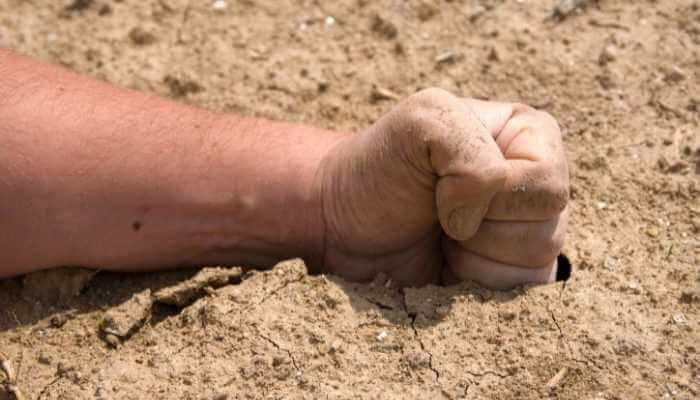
Add a Generous Amount of Compost or Organic Mulch
When you add a layer of compost or mulch to cover the top of the soil, you’re guaranteeing that the sun can’t evaporate the moisture so easily. It’s also a wind barrier. Not to mention, it can insulate your plants and make them less likely to suffer from late frosts (which we have gotten in NC) and overheating.
Mulch and compost covering also means that weeds will be less likely to get hold of your bed and thrive. Need one more good reason to use compost and mulch on top of your raised garden beds? How about, both covers will begin adding nutrients to the soil as they decompose further?
Be sure to use at least 2–3 inches of the cover layer to make sure it works. You don’t want to pull this over the plant, leave a ring around the base, but everywhere else, definitely.
Amend the Soil with Organic Materials or Clay
Amending soil, especially sandy soil, can be what the gardener orders. I’m used to very clay soil that retains water well. We moved nearer to the coast, and the soil was very sandy. So, I’ve amended the soil with some clay but also with coconut coir and rich composted soil.
These other types of soil will retain water much better and therefore have it ready for the plants to use. Coconut coir can hold over 30 times its weight in water, so though it may be expensive, it’s worth the purchase. Composting is something you can do in your own backyard. I plan on getting that started next month, actually. With the coco coir and worms, it should be a great success.
I plan on using the worm castings along with old dead leaves as amendable substrates in my raised bed gardens in the future. This should help keep water and add nutrients to them. You can do the same. You can also use other things as well: perlite, grass clippings (though be careful about spreading the seeds), shredded bark, leaf mold, any kind of composted material.
Make Sure the Soil in the Raised Bed Is Deep Enough
If your raised beds don’t have at least 12 inches (30cm) of soil, you’re asking for it to dry out quickly. To be honest, 18 inches (45cm) is the optimal amount of soil. The more soil you have in your bed, the more it keeps the moisture. Also, it just makes sense for giving the roots plenty of room to keep the plants healthy.
Plan to Use an Irrigation System
I plan to use a soaker hose called a drip hose in my container garden, I just haven’t gotten to it yet. So I’m making more work for myself, yes, I know. If you have the time and bit of money to invest, buy and install a drip hose system. You pretty much will not have to worry about them drying out.
You can lay them how you want them, making sure that you only water the soil and not the planter or the paths. You can use a regulator to make sure there isn’t too much released or wasted. And the best thing is you can place them beneath the leaves, closer to the roots, so that the right portion of the plant gets the water.
Water the Raised Garden Bed Deeply and Daily If It Does Not Rain Enough
When you water your raised bed garden, be sure you’re not just spraying the leafy tops of the plants. Get in close and gently water the soil. You want the roots to get the water, not the leaves. Besides, if you water from afar, you’re wasting a lot of that water into the air and if it’s on the leaf, it’s going to evaporate.
In the morning, my mother used to create moats around some of her beds to fill up with water on top of watering her plants normally. The water would soak in. The plants could use it throughout the day. I’m not sure this works, but I thought I’d mention it for those of you who have raised bed gardens on the ground itself.
No matter how you water your plants, it’s important to water for long enough that the moisture gets down beyond all covers and to the roots of the plants. So don’t think this is going to be a quick job. Though you want the containers to have drainage available, you should drench the soil before moving on, and in pots, that’s easy to see.
Gardening should be something that is a stress reliever. So, slow down and use the time you water your plants as a meditation of sorts. Breathe and quiet yourself. And if you take your time, your plants will appreciate it.
